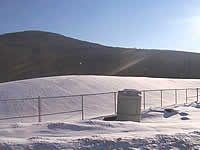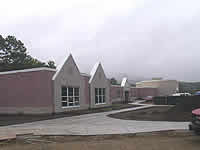Waste Site Cleanup & Reuse in New England
Chester Regional Elementary School
Success in EPA Brownfields Assessment Grant Program and Cleanup
Revolving Loan Fund Program
Chester, MA
(August 21, 2003)
On December 5th, 2002, the Pioneer Valley Planning Commission (PVPC) issued a $220,000 loan to the city of Chester, MA. The PVCP received its Brownfields Cleanup Revolving Loan funding from EPA New England in 1999. The loan was utilized to finance a cleanup at the 14-acre Chester Woodwaste Landfill site located on Middlefield Road in Chester. The cleanup of this site is critical to the redevelopment of the site since it will facilitate the construction of the Chester Regional Elementary School and associated athletic fields which will be built adjacent to the landfill. The cleanup was designed to eliminate the potential public health threats associated with the existing contamination. While the school will be ready for occupancy in November 2003, it is anticipated that the first classes will be offered at the new school in January 2004.
EPA New England awarded the PVPC two different brownfields grants
between 1998 and 1999. In 1998, the PVPC was selected as an Assessment
Demonstration Pilot and awarded $200,000 in assessment funding.
In May 1999, EPA selected the PVPC as a Brownfields Cleanup Revolving
Loan Fund (BCRLF) pilot. Under this program, EPA provided the PVPC
with $2,000,000 to capitalize the PVRBCRLF for its cities of Chicopee,
Springfield, Westfield and PVPC itself (for the balance of Pioneer
Valley Region, including the town of Chester). Each partner has
http://www.pvpc.org ![]() )
)
The PVPC represents forty-three cities and towns in the Pioneer Valley Region, the former Hampden and Hampshire counties, Massachusetts. The forty-three communities have a population of approximately 602,000 and are located in the central and western part of the state. The PVPC is a quasi-public, non-profit regional planning agency that provides planning, development, and other forms of technical assistance throughout the Pioneer Valley Region.
The PVPC is focusing its brownfields activities on working with the region’s communities to implement a strategic economic development plan that calls for a comprehensive regional approach to brownfields issues by working with many stakeholders including quasi-public non-profit developers, private non-profit developers and for profit developers.
The PVPC serves as the lead agency for the PVRBCRLF program and is responsible for ensuring that environmental cleanups conducted with funding from the PVRBCRLF are completed in compliance with all applicable laws and regulations and that the PVRBCRLF funds are utilized for authorized purposes. The PVPC also acts as the fund manager, while the Army Corps of Engineers (New England Division) acts as the site manager.
The loan was made to a municipality eligible for a discount of 20% of the loan amount. The town of Chester signed two promissary notes in support of the loan. The first note covered the discounted principal is $176,000. The interest rate for the loan will be 1%. A repayment schedule of the discounted principal and accrued interest was established based on ten annual payments starting March 2004. The second note for $44,000 will automatically discharge at the end of ten years if the discounted loan is repaid according to the original terms. Both notes are secured by the full faith and credit of the town of Chester. The source of repayment will be from the town’s general funds.
The town of Chester has owned the site since the 1940's. The site was used locally as a "stump dump" for the town. The town of Chester hired the engineering firm, Tighe & Bond of Westfield, MA, to complete an comprehensive environmental assessment of the site. The initial assessment was completed in September 2001 for $15,000. Shortly afterwards, the town obtained a grant from PVPC under its 1998 Assessment Demonstration Pilot award to conduct an additional environmental assessment for $27,000 to help pay for the documentation needed for the town’s loan from PVPC.
Once the site assessment effort was completed, the town hired the contractor, Clayton Davenport Trucking, Inc. of Greenfield, MA, to conduct the cleanup of the site. The cleanup costs included: construction, engineering and design fees, legal fees, and miscellaneous fees. The total cost of cleanup was $215,309.37 (the balance of the $220,000 funding commitment was utilized to install monitoring wells which were dug by the town’s highway crew to monitor the water quality). Originally, the loan amount was $250,000 from PVPC, but the town of Chester only needed $220,000 in funding to complete the project so the remaining loan commitment was never drawn down.
The cleanup began in August 2002 and was completed in October 2002. The contractors excavated and consolidated the wood waste debris and lead contaminated soil and placed it in an onsite landfill with a gas collection system and leachate control. (The lead-contaminated soil comes from an unknown source and was the driving force to conduct the cleanup.) The cleanup will prevent any unacceptable risk to the occupants of the new elementary school. The Massachusetts Department of Environmental Protection (MA DEP) approved the cleanup plan under its cleanup regulations: the Massachusetts Contingency Plan.
The Chester Regional Elementary School is a part of the Gateway Regional School District, who also participated in the hiring of the contractor and oversight of the construction of the school. The school district hired Fontain Brothers of Springfield, MA, to construct the school for the price of $4.9 million. The school construction began in October 2002 and should be substantially complete in October 2003. The school, which will hold classes between Kindergarten and fifth grade, should open in January 2004.



